Learning Environment: Curriculum, Assessment, and Modification
VerifiedAdded on 2020/02/03
|7
|1926
|42
Homework Assignment
AI Summary
This assignment delves into the multifaceted aspects of learning environments, encompassing curriculum frameworks, assessment tools, and modification strategies. It begins by defining curriculum within an outcome-based education context, emphasizing the importance of clear standards and alignment. The assignment then explores factors crucial for evaluating and modifying learning environments, focusing on children's needs, teaching materials, and physical space alterations. It provides practical ways to implement these modifications, such as varying seating arrangements and incorporating flexible learning materials. The assignment also addresses quality areas within the NQF when promoting appreciation of the natural environment, and explores how children and families contribute to the curriculum in early childhood education. Furthermore, it outlines various tools educators can utilize to assess children's knowledge and understanding, along with key considerations for observing children's learning and gathering feedback from families. The assignment concludes by matching definitions with relevant terms and identifying how educators promote dispositions for learning based on EYLF outcome 4.

Learning Environment
1
1
Paraphrase This Document
Need a fresh take? Get an instant paraphrase of this document with our AI Paraphraser
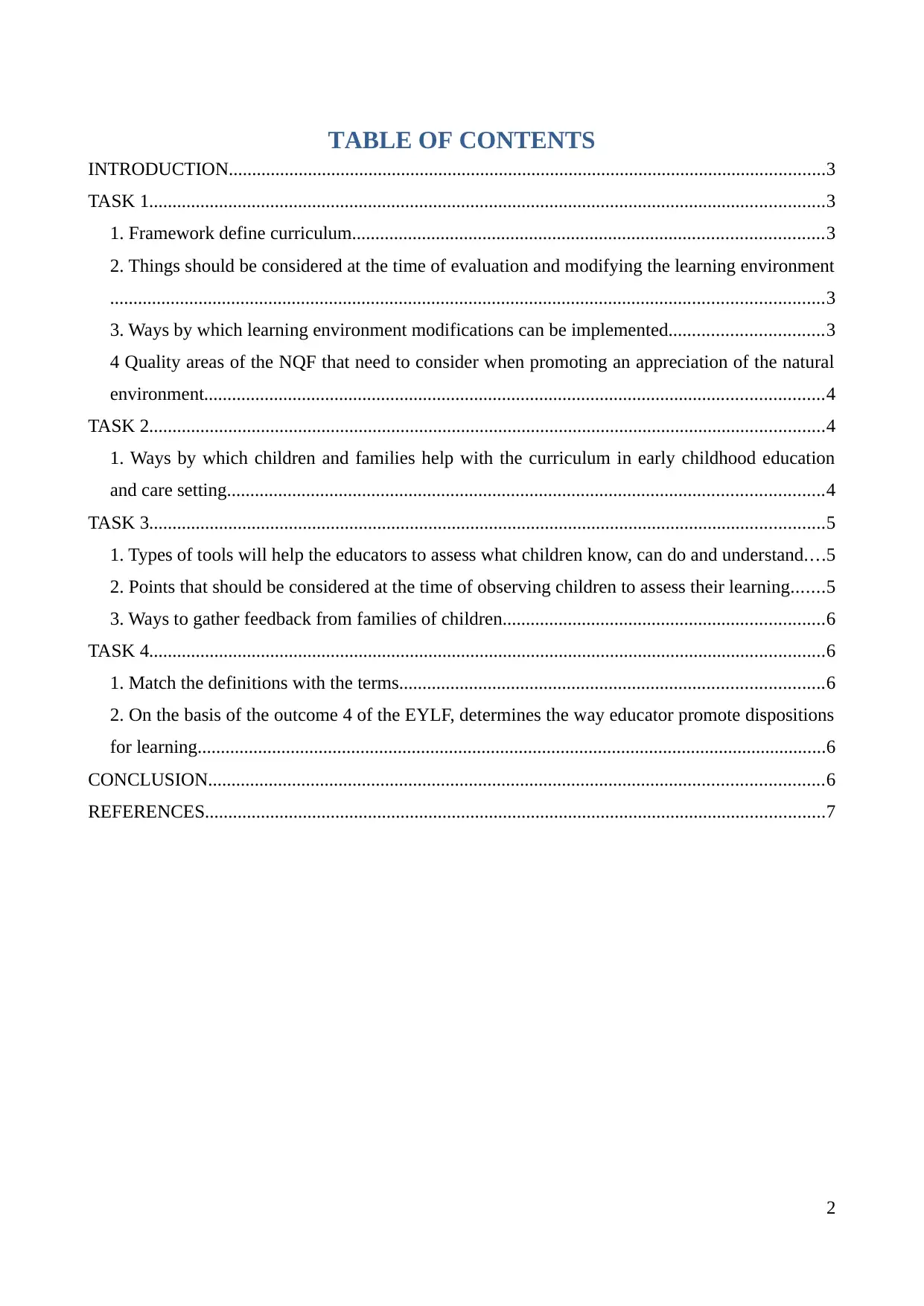
TABLE OF CONTENTS
INTRODUCTION................................................................................................................................3
TASK 1.................................................................................................................................................3
1. Framework define curriculum.....................................................................................................3
2. Things should be considered at the time of evaluation and modifying the learning environment
.........................................................................................................................................................3
3. Ways by which learning environment modifications can be implemented.................................3
4 Quality areas of the NQF that need to consider when promoting an appreciation of the natural
environment.....................................................................................................................................4
TASK 2.................................................................................................................................................4
1. Ways by which children and families help with the curriculum in early childhood education
and care setting................................................................................................................................4
TASK 3.................................................................................................................................................5
1. Types of tools will help the educators to assess what children know, can do and understand....5
2. Points that should be considered at the time of observing children to assess their learning.......5
3. Ways to gather feedback from families of children.....................................................................6
TASK 4.................................................................................................................................................6
1. Match the definitions with the terms...........................................................................................6
2. On the basis of the outcome 4 of the EYLF, determines the way educator promote dispositions
for learning.......................................................................................................................................6
CONCLUSION....................................................................................................................................6
REFERENCES.....................................................................................................................................7
2
INTRODUCTION................................................................................................................................3
TASK 1.................................................................................................................................................3
1. Framework define curriculum.....................................................................................................3
2. Things should be considered at the time of evaluation and modifying the learning environment
.........................................................................................................................................................3
3. Ways by which learning environment modifications can be implemented.................................3
4 Quality areas of the NQF that need to consider when promoting an appreciation of the natural
environment.....................................................................................................................................4
TASK 2.................................................................................................................................................4
1. Ways by which children and families help with the curriculum in early childhood education
and care setting................................................................................................................................4
TASK 3.................................................................................................................................................5
1. Types of tools will help the educators to assess what children know, can do and understand....5
2. Points that should be considered at the time of observing children to assess their learning.......5
3. Ways to gather feedback from families of children.....................................................................6
TASK 4.................................................................................................................................................6
1. Match the definitions with the terms...........................................................................................6
2. On the basis of the outcome 4 of the EYLF, determines the way educator promote dispositions
for learning.......................................................................................................................................6
CONCLUSION....................................................................................................................................6
REFERENCES.....................................................................................................................................7
2
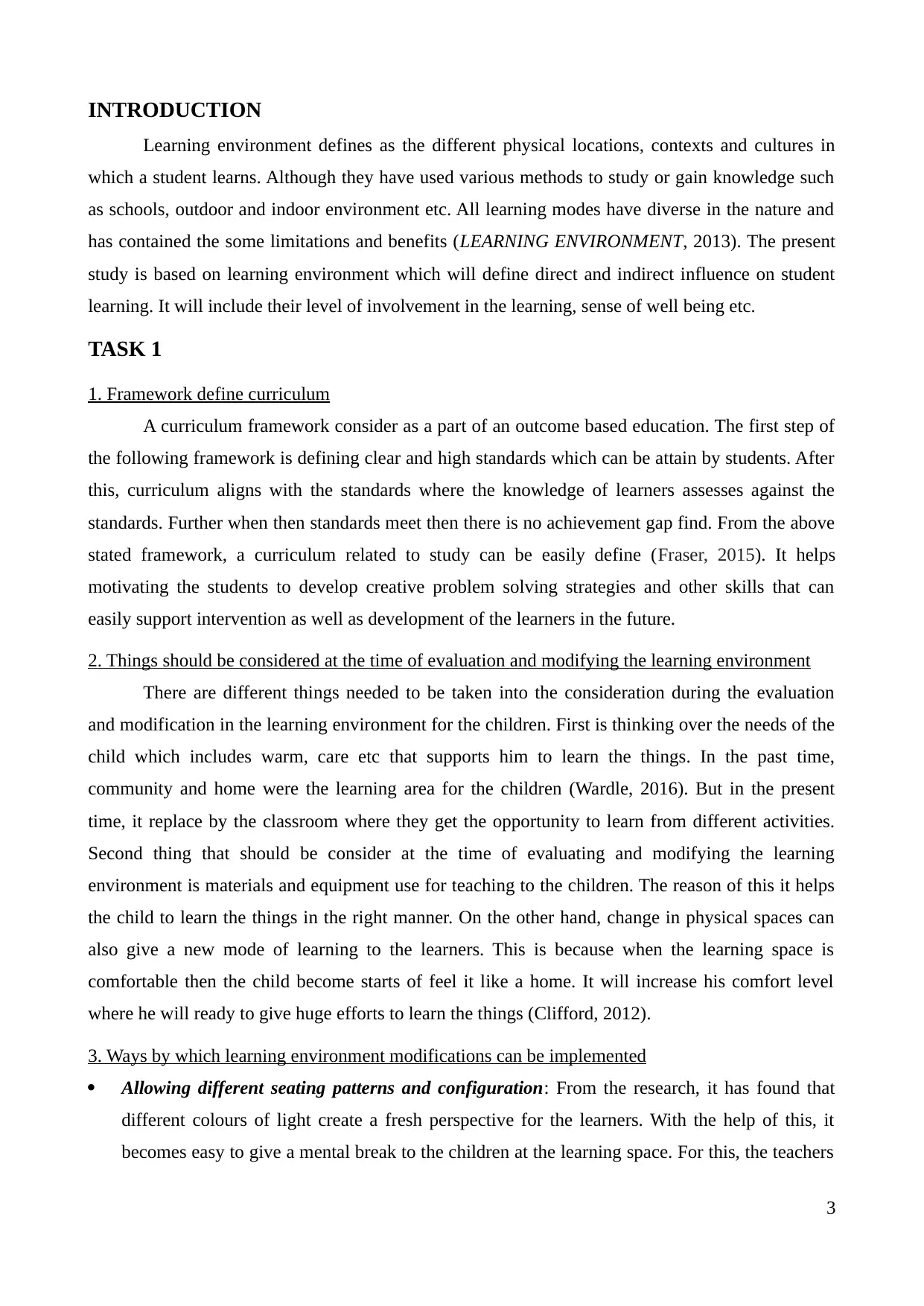
INTRODUCTION
Learning environment defines as the different physical locations, contexts and cultures in
which a student learns. Although they have used various methods to study or gain knowledge such
as schools, outdoor and indoor environment etc. All learning modes have diverse in the nature and
has contained the some limitations and benefits (LEARNING ENVIRONMENT, 2013). The present
study is based on learning environment which will define direct and indirect influence on student
learning. It will include their level of involvement in the learning, sense of well being etc.
TASK 1
1. Framework define curriculum
A curriculum framework consider as a part of an outcome based education. The first step of
the following framework is defining clear and high standards which can be attain by students. After
this, curriculum aligns with the standards where the knowledge of learners assesses against the
standards. Further when then standards meet then there is no achievement gap find. From the above
stated framework, a curriculum related to study can be easily define (Fraser, 2015). It helps
motivating the students to develop creative problem solving strategies and other skills that can
easily support intervention as well as development of the learners in the future.
2. Things should be considered at the time of evaluation and modifying the learning environment
There are different things needed to be taken into the consideration during the evaluation
and modification in the learning environment for the children. First is thinking over the needs of the
child which includes warm, care etc that supports him to learn the things. In the past time,
community and home were the learning area for the children (Wardle, 2016). But in the present
time, it replace by the classroom where they get the opportunity to learn from different activities.
Second thing that should be consider at the time of evaluating and modifying the learning
environment is materials and equipment use for teaching to the children. The reason of this it helps
the child to learn the things in the right manner. On the other hand, change in physical spaces can
also give a new mode of learning to the learners. This is because when the learning space is
comfortable then the child become starts of feel it like a home. It will increase his comfort level
where he will ready to give huge efforts to learn the things (Clifford, 2012).
3. Ways by which learning environment modifications can be implemented
Allowing different seating patterns and configuration: From the research, it has found that
different colours of light create a fresh perspective for the learners. With the help of this, it
becomes easy to give a mental break to the children at the learning space. For this, the teachers
3
Learning environment defines as the different physical locations, contexts and cultures in
which a student learns. Although they have used various methods to study or gain knowledge such
as schools, outdoor and indoor environment etc. All learning modes have diverse in the nature and
has contained the some limitations and benefits (LEARNING ENVIRONMENT, 2013). The present
study is based on learning environment which will define direct and indirect influence on student
learning. It will include their level of involvement in the learning, sense of well being etc.
TASK 1
1. Framework define curriculum
A curriculum framework consider as a part of an outcome based education. The first step of
the following framework is defining clear and high standards which can be attain by students. After
this, curriculum aligns with the standards where the knowledge of learners assesses against the
standards. Further when then standards meet then there is no achievement gap find. From the above
stated framework, a curriculum related to study can be easily define (Fraser, 2015). It helps
motivating the students to develop creative problem solving strategies and other skills that can
easily support intervention as well as development of the learners in the future.
2. Things should be considered at the time of evaluation and modifying the learning environment
There are different things needed to be taken into the consideration during the evaluation
and modification in the learning environment for the children. First is thinking over the needs of the
child which includes warm, care etc that supports him to learn the things. In the past time,
community and home were the learning area for the children (Wardle, 2016). But in the present
time, it replace by the classroom where they get the opportunity to learn from different activities.
Second thing that should be consider at the time of evaluating and modifying the learning
environment is materials and equipment use for teaching to the children. The reason of this it helps
the child to learn the things in the right manner. On the other hand, change in physical spaces can
also give a new mode of learning to the learners. This is because when the learning space is
comfortable then the child become starts of feel it like a home. It will increase his comfort level
where he will ready to give huge efforts to learn the things (Clifford, 2012).
3. Ways by which learning environment modifications can be implemented
Allowing different seating patterns and configuration: From the research, it has found that
different colours of light create a fresh perspective for the learners. With the help of this, it
becomes easy to give a mental break to the children at the learning space. For this, the teachers
3
⊘ This is a preview!⊘
Do you want full access?
Subscribe today to unlock all pages.

Trusted by 1+ million students worldwide
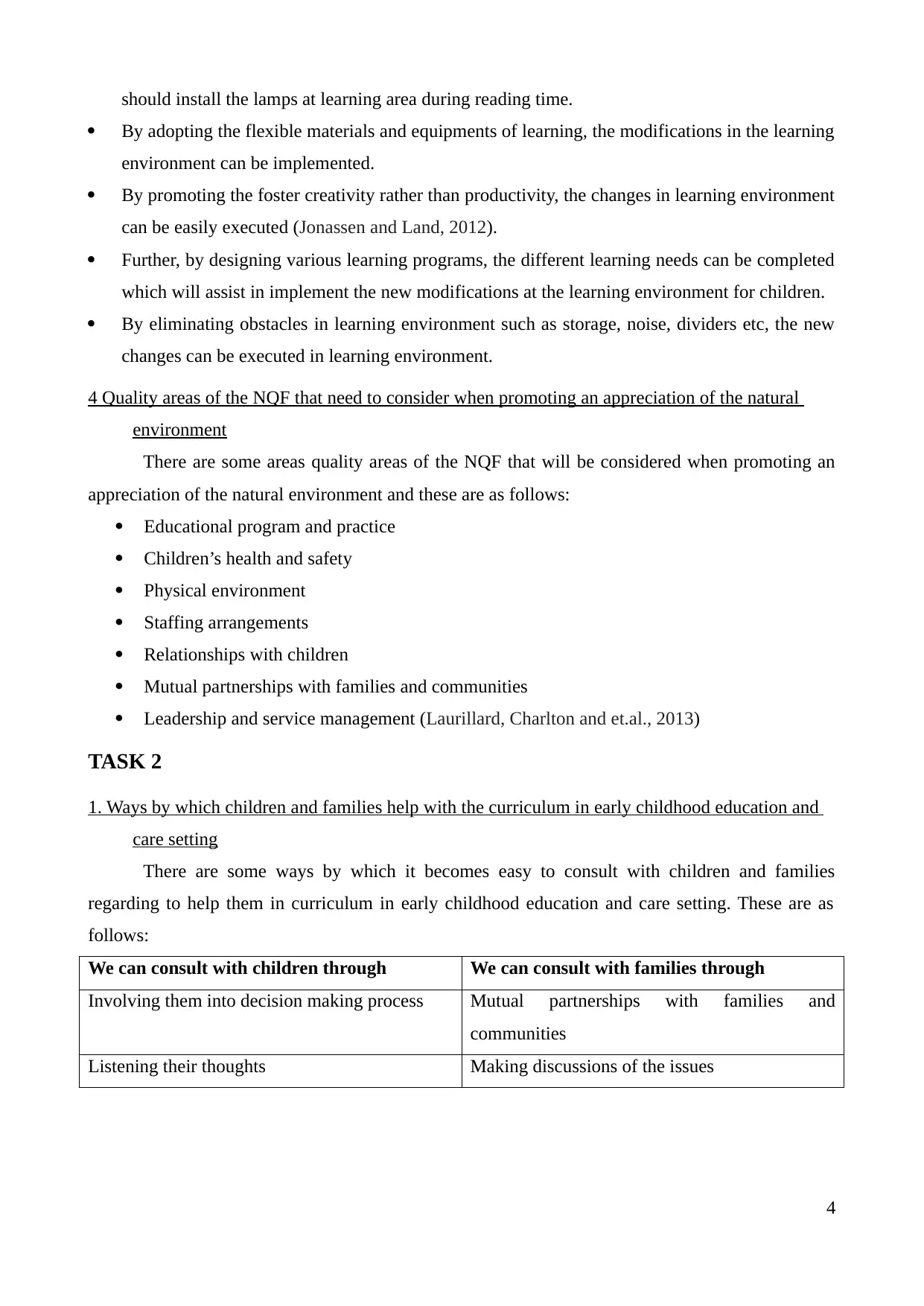
should install the lamps at learning area during reading time.
By adopting the flexible materials and equipments of learning, the modifications in the learning
environment can be implemented.
By promoting the foster creativity rather than productivity, the changes in learning environment
can be easily executed (Jonassen and Land, 2012).
Further, by designing various learning programs, the different learning needs can be completed
which will assist in implement the new modifications at the learning environment for children.
By eliminating obstacles in learning environment such as storage, noise, dividers etc, the new
changes can be executed in learning environment.
4 Quality areas of the NQF that need to consider when promoting an appreciation of the natural
environment
There are some areas quality areas of the NQF that will be considered when promoting an
appreciation of the natural environment and these are as follows:
Educational program and practice
Children’s health and safety
Physical environment
Staffing arrangements
Relationships with children
Mutual partnerships with families and communities
Leadership and service management (Laurillard, Charlton and et.al., 2013)
TASK 2
1. Ways by which children and families help with the curriculum in early childhood education and
care setting
There are some ways by which it becomes easy to consult with children and families
regarding to help them in curriculum in early childhood education and care setting. These are as
follows:
We can consult with children through We can consult with families through
Involving them into decision making process Mutual partnerships with families and
communities
Listening their thoughts Making discussions of the issues
4
By adopting the flexible materials and equipments of learning, the modifications in the learning
environment can be implemented.
By promoting the foster creativity rather than productivity, the changes in learning environment
can be easily executed (Jonassen and Land, 2012).
Further, by designing various learning programs, the different learning needs can be completed
which will assist in implement the new modifications at the learning environment for children.
By eliminating obstacles in learning environment such as storage, noise, dividers etc, the new
changes can be executed in learning environment.
4 Quality areas of the NQF that need to consider when promoting an appreciation of the natural
environment
There are some areas quality areas of the NQF that will be considered when promoting an
appreciation of the natural environment and these are as follows:
Educational program and practice
Children’s health and safety
Physical environment
Staffing arrangements
Relationships with children
Mutual partnerships with families and communities
Leadership and service management (Laurillard, Charlton and et.al., 2013)
TASK 2
1. Ways by which children and families help with the curriculum in early childhood education and
care setting
There are some ways by which it becomes easy to consult with children and families
regarding to help them in curriculum in early childhood education and care setting. These are as
follows:
We can consult with children through We can consult with families through
Involving them into decision making process Mutual partnerships with families and
communities
Listening their thoughts Making discussions of the issues
4
Paraphrase This Document
Need a fresh take? Get an instant paraphrase of this document with our AI Paraphraser
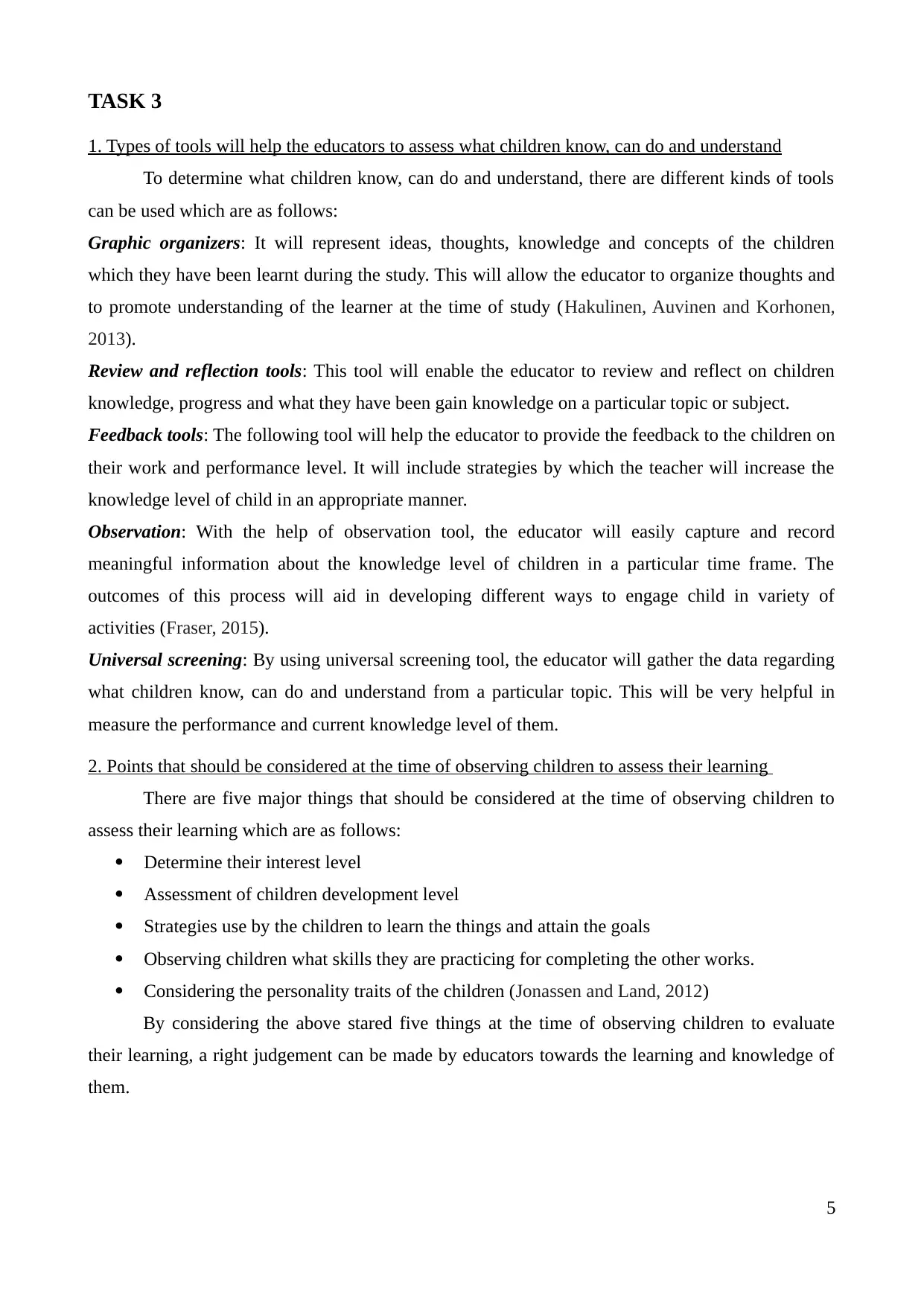
TASK 3
1. Types of tools will help the educators to assess what children know, can do and understand
To determine what children know, can do and understand, there are different kinds of tools
can be used which are as follows:
Graphic organizers: It will represent ideas, thoughts, knowledge and concepts of the children
which they have been learnt during the study. This will allow the educator to organize thoughts and
to promote understanding of the learner at the time of study (Hakulinen, Auvinen and Korhonen,
2013).
Review and reflection tools: This tool will enable the educator to review and reflect on children
knowledge, progress and what they have been gain knowledge on a particular topic or subject.
Feedback tools: The following tool will help the educator to provide the feedback to the children on
their work and performance level. It will include strategies by which the teacher will increase the
knowledge level of child in an appropriate manner.
Observation: With the help of observation tool, the educator will easily capture and record
meaningful information about the knowledge level of children in a particular time frame. The
outcomes of this process will aid in developing different ways to engage child in variety of
activities (Fraser, 2015).
Universal screening: By using universal screening tool, the educator will gather the data regarding
what children know, can do and understand from a particular topic. This will be very helpful in
measure the performance and current knowledge level of them.
2. Points that should be considered at the time of observing children to assess their learning
There are five major things that should be considered at the time of observing children to
assess their learning which are as follows:
Determine their interest level
Assessment of children development level
Strategies use by the children to learn the things and attain the goals
Observing children what skills they are practicing for completing the other works.
Considering the personality traits of the children (Jonassen and Land, 2012)
By considering the above stared five things at the time of observing children to evaluate
their learning, a right judgement can be made by educators towards the learning and knowledge of
them.
5
1. Types of tools will help the educators to assess what children know, can do and understand
To determine what children know, can do and understand, there are different kinds of tools
can be used which are as follows:
Graphic organizers: It will represent ideas, thoughts, knowledge and concepts of the children
which they have been learnt during the study. This will allow the educator to organize thoughts and
to promote understanding of the learner at the time of study (Hakulinen, Auvinen and Korhonen,
2013).
Review and reflection tools: This tool will enable the educator to review and reflect on children
knowledge, progress and what they have been gain knowledge on a particular topic or subject.
Feedback tools: The following tool will help the educator to provide the feedback to the children on
their work and performance level. It will include strategies by which the teacher will increase the
knowledge level of child in an appropriate manner.
Observation: With the help of observation tool, the educator will easily capture and record
meaningful information about the knowledge level of children in a particular time frame. The
outcomes of this process will aid in developing different ways to engage child in variety of
activities (Fraser, 2015).
Universal screening: By using universal screening tool, the educator will gather the data regarding
what children know, can do and understand from a particular topic. This will be very helpful in
measure the performance and current knowledge level of them.
2. Points that should be considered at the time of observing children to assess their learning
There are five major things that should be considered at the time of observing children to
assess their learning which are as follows:
Determine their interest level
Assessment of children development level
Strategies use by the children to learn the things and attain the goals
Observing children what skills they are practicing for completing the other works.
Considering the personality traits of the children (Jonassen and Land, 2012)
By considering the above stared five things at the time of observing children to evaluate
their learning, a right judgement can be made by educators towards the learning and knowledge of
them.
5
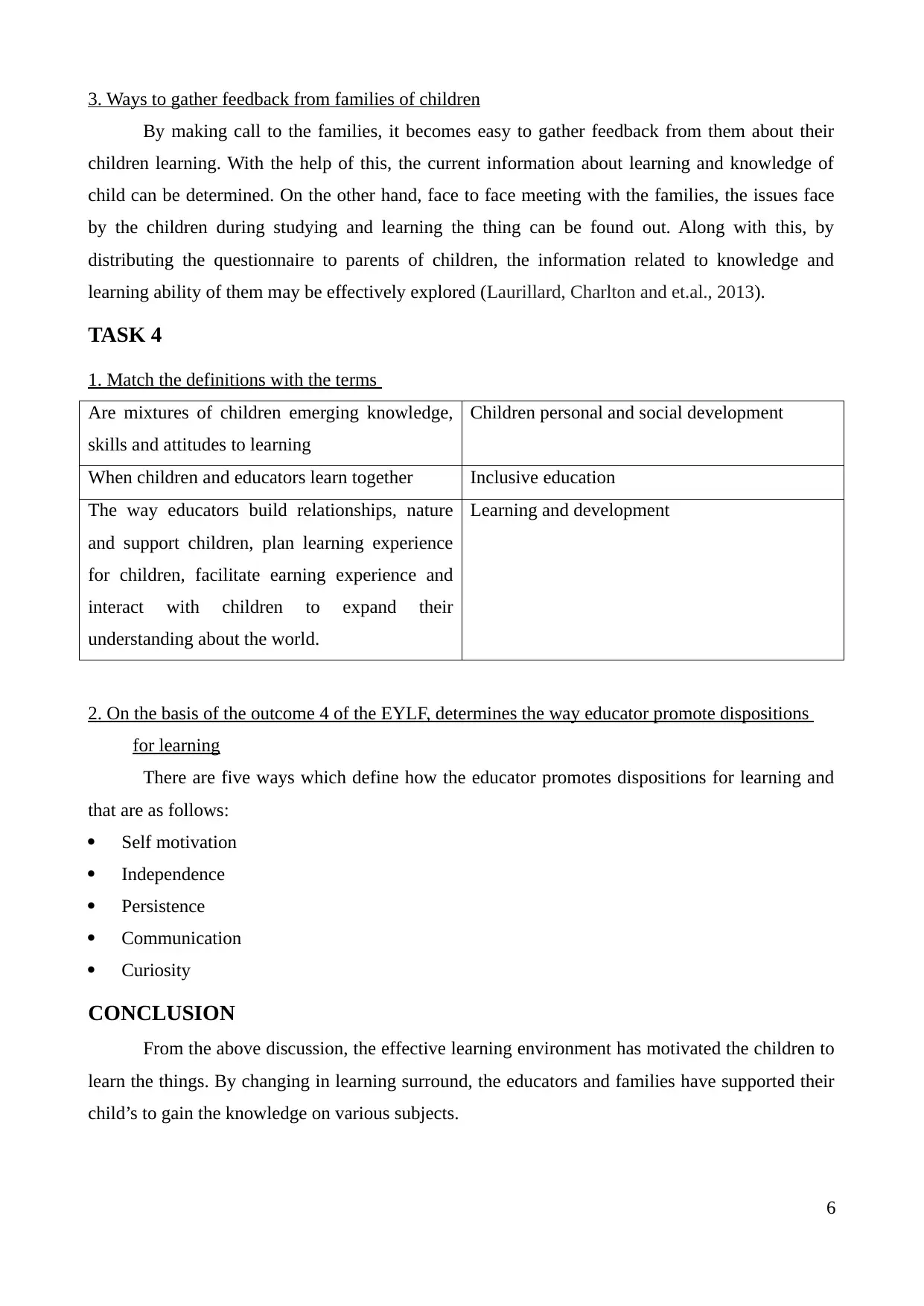
3. Ways to gather feedback from families of children
By making call to the families, it becomes easy to gather feedback from them about their
children learning. With the help of this, the current information about learning and knowledge of
child can be determined. On the other hand, face to face meeting with the families, the issues face
by the children during studying and learning the thing can be found out. Along with this, by
distributing the questionnaire to parents of children, the information related to knowledge and
learning ability of them may be effectively explored (Laurillard, Charlton and et.al., 2013).
TASK 4
1. Match the definitions with the terms
Are mixtures of children emerging knowledge,
skills and attitudes to learning
Children personal and social development
When children and educators learn together Inclusive education
The way educators build relationships, nature
and support children, plan learning experience
for children, facilitate earning experience and
interact with children to expand their
understanding about the world.
Learning and development
2. On the basis of the outcome 4 of the EYLF, determines the way educator promote dispositions
for learning
There are five ways which define how the educator promotes dispositions for learning and
that are as follows:
Self motivation
Independence
Persistence
Communication
Curiosity
CONCLUSION
From the above discussion, the effective learning environment has motivated the children to
learn the things. By changing in learning surround, the educators and families have supported their
child’s to gain the knowledge on various subjects.
6
By making call to the families, it becomes easy to gather feedback from them about their
children learning. With the help of this, the current information about learning and knowledge of
child can be determined. On the other hand, face to face meeting with the families, the issues face
by the children during studying and learning the thing can be found out. Along with this, by
distributing the questionnaire to parents of children, the information related to knowledge and
learning ability of them may be effectively explored (Laurillard, Charlton and et.al., 2013).
TASK 4
1. Match the definitions with the terms
Are mixtures of children emerging knowledge,
skills and attitudes to learning
Children personal and social development
When children and educators learn together Inclusive education
The way educators build relationships, nature
and support children, plan learning experience
for children, facilitate earning experience and
interact with children to expand their
understanding about the world.
Learning and development
2. On the basis of the outcome 4 of the EYLF, determines the way educator promote dispositions
for learning
There are five ways which define how the educator promotes dispositions for learning and
that are as follows:
Self motivation
Independence
Persistence
Communication
Curiosity
CONCLUSION
From the above discussion, the effective learning environment has motivated the children to
learn the things. By changing in learning surround, the educators and families have supported their
child’s to gain the knowledge on various subjects.
6
⊘ This is a preview!⊘
Do you want full access?
Subscribe today to unlock all pages.

Trusted by 1+ million students worldwide
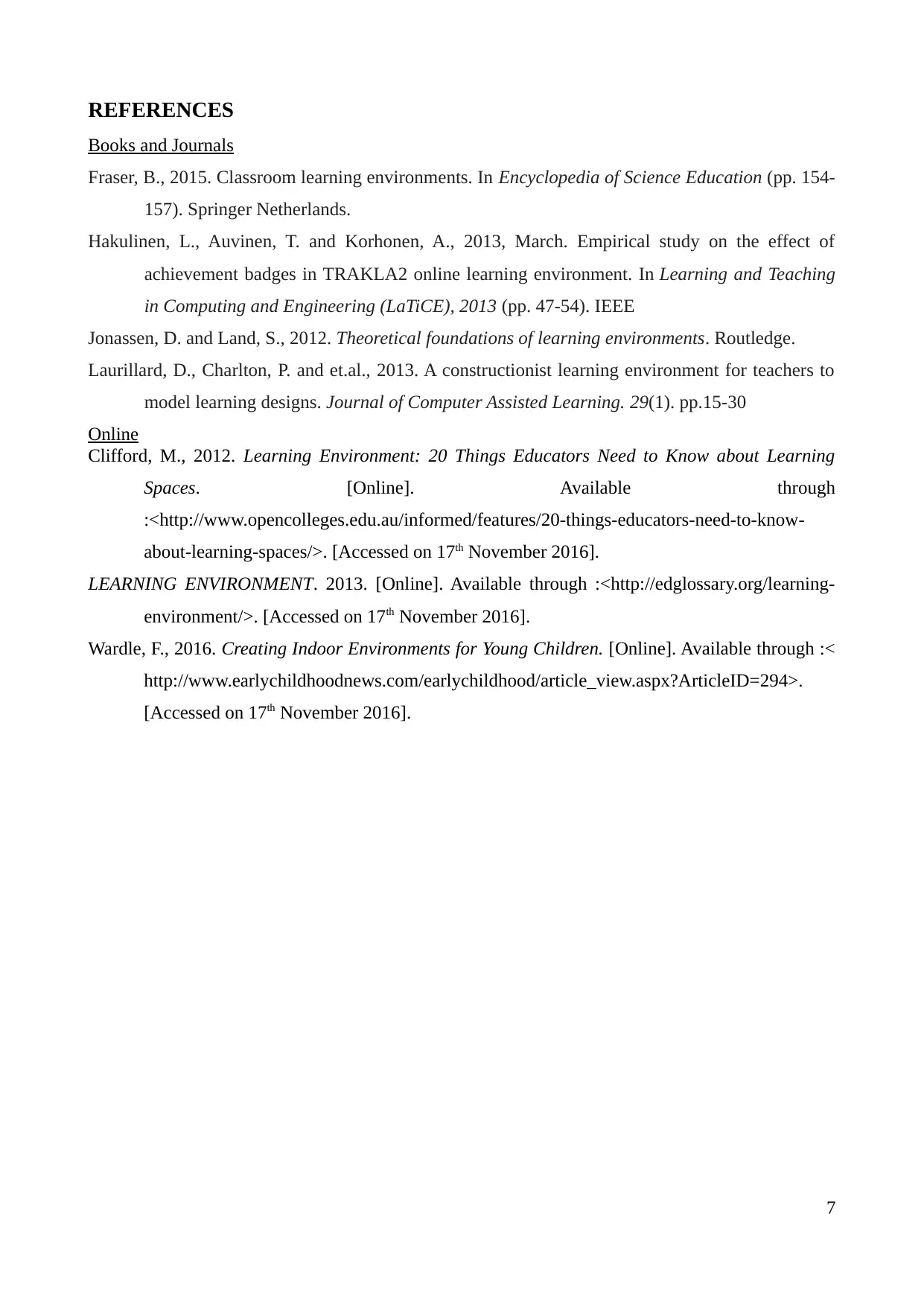
REFERENCES
Books and Journals
Fraser, B., 2015. Classroom learning environments. In Encyclopedia of Science Education (pp. 154-
157). Springer Netherlands.
Hakulinen, L., Auvinen, T. and Korhonen, A., 2013, March. Empirical study on the effect of
achievement badges in TRAKLA2 online learning environment. In Learning and Teaching
in Computing and Engineering (LaTiCE), 2013 (pp. 47-54). IEEE
Jonassen, D. and Land, S., 2012. Theoretical foundations of learning environments. Routledge.
Laurillard, D., Charlton, P. and et.al., 2013. A constructionist learning environment for teachers to
model learning designs. Journal of Computer Assisted Learning. 29(1). pp.15-30
Online
Clifford, M., 2012. Learning Environment: 20 Things Educators Need to Know about Learning
Spaces. [Online]. Available through
:<http://www.opencolleges.edu.au/informed/features/20-things-educators-need-to-know-
about-learning-spaces/>. [Accessed on 17th November 2016].
LEARNING ENVIRONMENT. 2013. [Online]. Available through :<http://edglossary.org/learning-
environment/>. [Accessed on 17th November 2016].
Wardle, F., 2016. Creating Indoor Environments for Young Children. [Online]. Available through :<
http://www.earlychildhoodnews.com/earlychildhood/article_view.aspx?ArticleID=294>.
[Accessed on 17th November 2016].
7
Books and Journals
Fraser, B., 2015. Classroom learning environments. In Encyclopedia of Science Education (pp. 154-
157). Springer Netherlands.
Hakulinen, L., Auvinen, T. and Korhonen, A., 2013, March. Empirical study on the effect of
achievement badges in TRAKLA2 online learning environment. In Learning and Teaching
in Computing and Engineering (LaTiCE), 2013 (pp. 47-54). IEEE
Jonassen, D. and Land, S., 2012. Theoretical foundations of learning environments. Routledge.
Laurillard, D., Charlton, P. and et.al., 2013. A constructionist learning environment for teachers to
model learning designs. Journal of Computer Assisted Learning. 29(1). pp.15-30
Online
Clifford, M., 2012. Learning Environment: 20 Things Educators Need to Know about Learning
Spaces. [Online]. Available through
:<http://www.opencolleges.edu.au/informed/features/20-things-educators-need-to-know-
about-learning-spaces/>. [Accessed on 17th November 2016].
LEARNING ENVIRONMENT. 2013. [Online]. Available through :<http://edglossary.org/learning-
environment/>. [Accessed on 17th November 2016].
Wardle, F., 2016. Creating Indoor Environments for Young Children. [Online]. Available through :<
http://www.earlychildhoodnews.com/earlychildhood/article_view.aspx?ArticleID=294>.
[Accessed on 17th November 2016].
7
1 out of 7
Related Documents
Your All-in-One AI-Powered Toolkit for Academic Success.
+13062052269
info@desklib.com
Available 24*7 on WhatsApp / Email
![[object Object]](/_next/static/media/star-bottom.7253800d.svg)
Unlock your academic potential
Copyright © 2020–2025 A2Z Services. All Rights Reserved. Developed and managed by ZUCOL.




